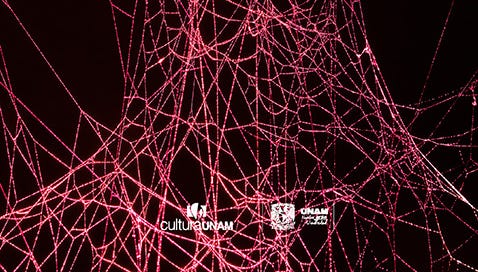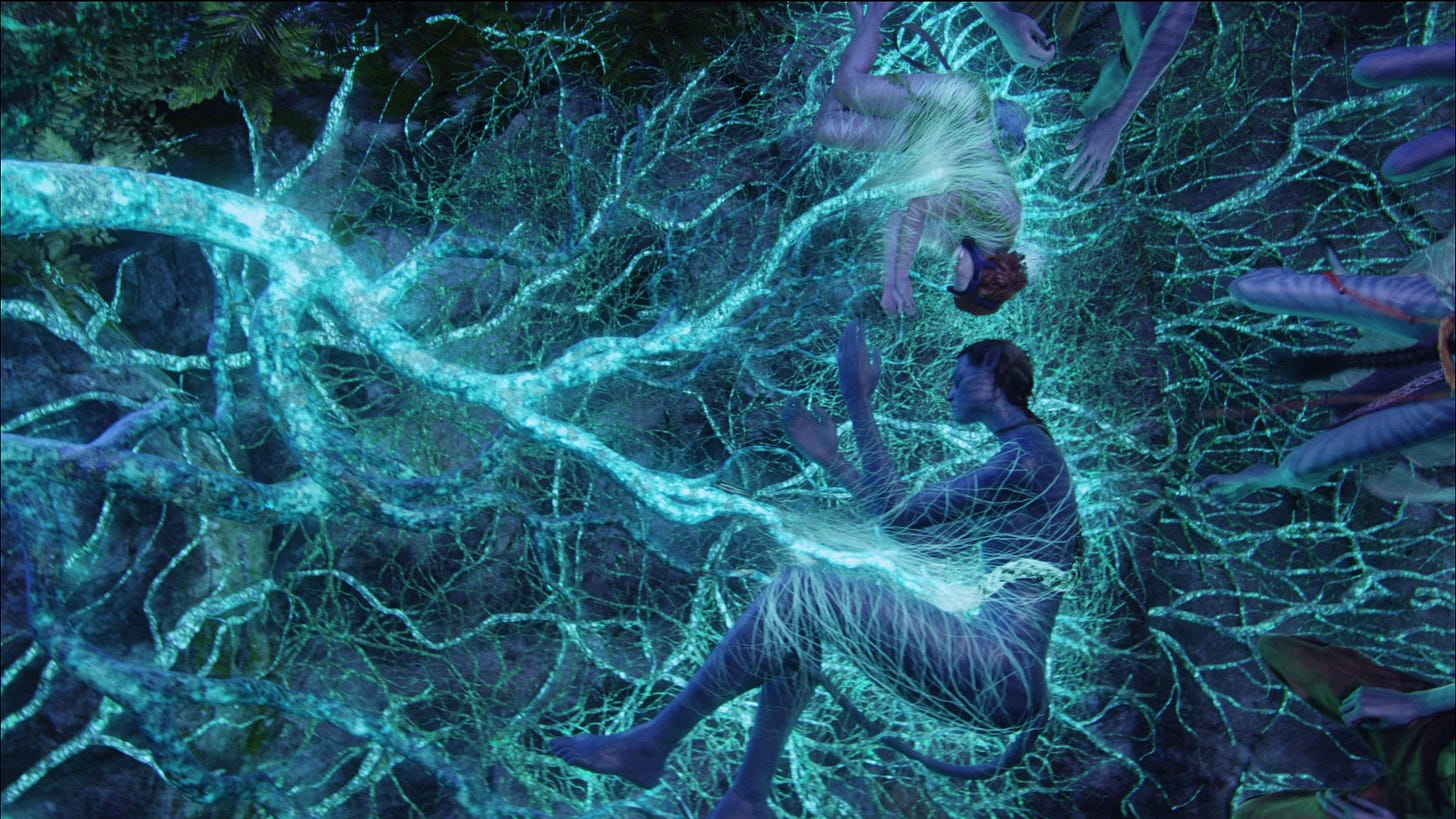Mycelium, Mycology, and Metaphor
Despite the best of intentions, the metaphor of mycelial networks undermines connection between people and the natural world
The idea of “mycelial networks” is so buzzy right now. Folks throw around the phrase to illustrate everything from a cooperative vibe in a conference room to Buddhist ideas of interconnectedness with nature and her inherent wisdom, but frankly, I find it kind of annoying that the metaphor has drifted so far away from the mycology. Because from what I can tell, there’s a lot of confusion about just what a mycelial connection is (and isn’t).
I recently published an essay on this subject in Revista de la Universidad de México, a National Autonomous University of Mexico's cultural magazine, translated by Pablo Duarte. The piece is beautifully illustrated with images of work by Rodrigo Arteaga Abarca. I rarely write for magazines anymore, so this was really a pleasure.
Here’s how it came about: the editors of the magazine had reached out saying they were planning an issue around networks, and wanted to know if I would be interested in writing about mycelium. At first I was afraid they, like so many others, were smitten with the notion of the “mycelial connection,” and would want some kind of Hallmark version of nature where only good things happen, but if they were, they were quick to let it go and embrace my opinion that the metaphor becomes more potent if you understand a little mycology.
So for those of you who don’t read Spanish, below is the English original. (I don’t recommend selecting “translate” if you open the magazine—that’s a game of telephone run amok.)
It used to be when I went to a dinner party and I’d tell my dining companion I was into mushrooms and molds, inevitably they’d start looking for somewhere else to sit. But not anymore. I just published a book about magic mushrooms (it’s called Have a Good Trip) and now I am the one looking for somewhere else to sit, otherwise I’m trapped answering a bazillion questions about Psilocybe mushrooms, and mushrooms more generally.
Interest in fungi has swelled; mushrooms are the newest health and wellness trend. The mushroom clubs, once the domain of retired hobbyists, a few cranks, and the occasional quirky child, are now populated with folks making careers in cultivation, education, product manufacture, and guiding, both in the woods and, for those into magic mushrooms, in the mind. These days I’m drowning in internet alerts about mushroom forays, recipes, cures, fashion, art, music, and design from serious to kitsch, mushroom environmental remediation, new product development and engineering, and fungi’s impact on agriculture. But most of all, I’ve noticed that the hackneyed use of the term mycelium, which refers to the feeding structure of certain fungal species, has become virtually synonymous with the healing powers of helping each other.
This last notion derives from mostly 21st century research showing that the forest is not just a collection of trees, but a community connected underground by one or more fungal mycelia that sustain balance and well-being in the ecosystem.[1] This new understanding of forest ecosystems has proliferated through movies like Avatar and Fantastic Fungi which gave fungi voice and intention, thanks to actress Brie Larson; books like The Secret Life of Trees and television shows like Star Trek: Discovery which developed a plot line in its first season about the mycelial network, “a vast microscopic web…that spans the multiverse.” Countless podcasts, businesses, and seminars applaud the wonders of the “mycelial connection,” even promoting the idea of a “Human Mycelium” which “draws an analogy between the mycelial networks formed by fungi and the interconnectedness of human beings.” The relationship between trees and certain fungi seems to have morphed beyond the boundaries of their biology and become a symbol of the inherent goodness of interdependent relationships. Too bad that’s a very narrow understanding of the mycology.
Still from the movie Avatar dir. James Cameron (2009)
But I have an idea of why it’s happening. As more and more people (in the USA anyway) experience how divisive and scary our world is today, metaphors about the innate goodness of fungi can bring a sense of hope and promise that our better natures will prevail.
I am not interested in degrading that sentiment—I’d prefer our better natures prevail, too--but I think when sentiment replaces science, it distracts us from a deeper appreciation of the complexity of nature, and that could inhibit actual ecological cooperation. I’m not alone in this thinking. In their paper “Positive citation bias and overinterpreted results lead to misinformation on common mycorrhizal networks in forests,” the authors point out that while they are “thrilled that the public has become as excited as we are about the many roles that fungi play in forests…[n]onetheless, it is important for the public and scientific community to understand the nature and extent of the evidence for the roles played by common mycorrhizal networks in forests.”
So for those who are in love with the idea of the mycelial network, here’s a quick overview of what is known about these amazing organisms. Of the many fungal species, some are single celled, like yeasts, and others are multicellular, like molds and the species that produce mushrooms. The multicellular form of a fungus is called the mycelium (plus there are other multicellular structures that occur, like sclerotia or rhizomorphs but we are not talking about those today). A mycelium is a web of microscopic tubes that seeks and consumes food. It contains a fungus’ genetic info, it can regenerate when torn apart as it has no front or back, and it can fuse with other, compatible mycelia.
A mycelium grows from a spore, which is like a tiny, light seed that contains only a little bit of energy. When an airborne spore lands on the food it likes to eat it has just enough energy to germinate. That’s why it is so important a spore lands on its food—so it can start consuming right away (and that’s also why a fungus, however it does so, launches many, many spores into its environment; to increase the chances that a spore will land on something edible).
Fungi are too small to have stomachs, so they digest food outside their bodies. If you were a fungal spore and you landed on your preferred food, say, a strawberry, you would seep out your digestive juices, break down the strawberry flesh, and absorb the nutrients, like water, nitrogen, phosphorus, and sugar, and then you’d have the energy to grow a little bigger, one cell at a time into long tube-like threads called hyphae. As the hyphae grow, they branch and rebranch, each tip an absorption point that explores their environment for food and in some cases, for symbiotic partners. (This paper shares some very interesting new science on the growth pattern of mycelia.) This mass of hyphal threads is called a mycelium. A mycelium can grow in any dimension or direction there is food to grow into, which is why the mycelium of a fungus like ring worm is only skin deep. Tinea corporis consumes keratin in skin, not tissue. It doesn’t grow where there isn’t food.
Creator: reanas | Credit: Getty Images/iStockphoto Copyright: reanas
Since fungi are absorptive organisms, one way to describe the way they live is by what they eat. Fungi don’t make the carbon they need so they must get it from elsewhere. Parasitic fungi—mostly blights and rots of plants--get their carbon by predation: they kill their prey and consume the prey’s carbon. Saprobic fungi get their carbon by eating dead and dying stuff, mainly plants. When you kick open a rotting log, that fluffy white stuff is the mycelium of saprobic fungi which is busy consuming the wood’s nutrients. Mutualists, which include endophytic fungi and mycorrhizal fungi, get their carbon through trade with a living plant.
It's the mycorrhizal fungi that people are referring to when they speak of the mycelium network—whether they know it or not. But it’s helpful to know, I think, that a mycelium is the thallus--an undifferentiated body--of many multicellular fungi including parasites. Which means the “mycelial network” metaphor is less about the mycelium and more about how particular mycelia get their food.
It has long been established that most plants—70 to 90%--participate in mutualistic relationships with fungi. It has been described as a trade: part of the fungus attaches to the root tips of the plant. The rest forages in the soil and delivers micronutrients in a readily assimilated form that the plant needs, like phosphorus, but can’t make. In exchange or trade, the plant shares with the fungus sugars it makes by means of photosynthesis.
But what bumped mycorrhizae into the realm of metaphor started with the work of Dr. Suzanne Simard from the University of British Columbia. Simard discovered that fungi attach to the roots of multiple trees in a particular ecosystem, in essence creating nutritional pipelines from which the trees might benefit, and in the process defining a particular forest community. As she wrote in her book, Finding the Mother Tree, this cooperation “challenge[s] the prevailing theory that cooperation is of less importance than competition in evolution and ecology.”
Simard and her colleagues proved this with a simple, well-crafted field experiment: she labeled tree sugars with radioactive isotopes and then tracked them as they traveled through fungal hyphae into the root tips of other trees. Her paper was published in Nature in 1996, and it made the cover, beating out the discovery of the fruit fly genome (more important than it sounds). The editors of Nature came up with the title “The Wood Wide Web” and today it’s shorthand for more than the networks of trees and their fungal symbionts in a given ecosystem; it has become what Richard Power’s calls in The Overstory “The Gospel of New Forestry” (the character Patricia Westerfield is based on Simard) and a metaphor for cooperation as a means to success and happiness.
Suzanne’s work suggests that through fungal networks trees share resources, and mature trees (what she calls “hub trees” in her research and “mother trees” when speaking to popular audiences) support seedlings, favor their kin, and distribute resources, even in death. Weaker plants will tap into this network, like crashers at an all-you-can-eat buffet. Young seedlings struggling to grow in the shadow of a canopy may tap into the larger, older tree’s fungal network to supplement their nutrition. This network benefits not only established trees and seedlings of the same species, but also trees from different species, and at different stages of development. So one multitasking fungus, its hyphae attached to the roots of multiple trees in the forest, can simultaneously provide a different nutritional load as needed to different trees. “In one forest we found 47 trees linked by two species of fungi composed of twelve individuals,” said Simard. (When she says individuals, she means two genetically distinct fungal entities.) “Talk about two degrees of separation!”
Nor is Simard the only scientist to pursue this radical new understanding of plants and their mycorrhizal connections. A 2013 study by scientists at the University of Aberdeen found that bean plants connected to one another by mycorrhizal fungi can convey chemical “warnings” of an impending attack through the fungal hyphae they share.
The mutualistic nature of the plant/fungus relationship is what fuels people’s enthusiasm about the so-called mycelium network. But that’s not the whole picture. Fungi may provide environmental services to plants in an ecosystem, but they also may deny those services. It depends on what’s in their own best interest.
For example, a paper that came out in PNAS in late January titled “Evolution of signaling and monitoring in plant-fungal networks” suggests that the mycorrhizal fungus probably doesn’t help plants because it’s a good thing to do, but rather when a fungus that connects two plants detects an aphid attack and signals the other plants in the network, it does so because it is evolutionarily beneficial for the fungus to have multiple symbiotic partners.
Illustration from The evolution of signaling and monitoring in plant–fungal networks
Mutualism is ultimately about commonly shared self-interest. In forest ecosystems, fungal networks may determine which plants need its foraged nutrients the most, and which plants have the most carbon to offer. Fungi don’t partner up with just any plant; sometimes they prefer partnerships with plants some distance away because the carbon payoff is greater. “The fungus is basically a microbe that plays economic games,” said Tom Shimizu a biophysicist at AMOLF, a physics institute in Amsterdam in a New York Times article. The flows of carbon in fungal hyphae, according to evolutionary biologist Toby Kiers of the Society for the Protection of Underground Networks, are under fungal control. But how the fungus moves these nutrients around is unknown, as is how a noncognitive organism like a fungus makes decisions.
The late mycologist Tom Volk used to describe the plant-fungus symbiosis as a hostage situation, where the fungus holds back nutrients to the tree unless it delivers the sugar. That’s quite different from Suzanne Simard’s sympathetic interpretation of the plant/fungus relationship.
It seems to me that the “mycelium network” metaphor is based on two cherry-picked ideas. The first is that mycelium is by nature a magnanimous organism. It is not. It is the thallus of multicellular fungi, some of which are parasites, some saprobes, some mycorrhizae. Mycelium has become a stand in word for a mycorrhizal fungus and its role in a forest ecosystem.
The second cherry-picked idea is that mycorrhizal fungi play an altruistic role in the environment. You can look at that role as being beneficent, but there’s no proof of that characterization. Indeed, there may be more evidence supporting the idea that mycorrhizal fungi function based on self-interest.
Characterizing mycelium as generous nurturers of forest ecosystems is a kind of anthropomorphism, where we have attributed human characteristics to fungi. Anthropomorphism is an established tool of science communication. It’s used to help people who don’t understand a science feel connected to it. And certainly not a lot of people know much about mycology. For most of academic history, mushrooms were studied (to the extent they were studied at all) within university botany departments. Traditionally, botanists lumped fungi together with plants when in fact, fungi constitute a huge, unique taxonomic rank representing a wide range of lifestyles and morphologies.
But unless you take graduate level biology, a student’s exposure to fungi may be scant. I went back to my old university, Columbia in New York, to study undergrad biology for a year and we had one lecture on fungi. One.
When someone who lacks a background in basic mycology first learns about fungi--their ubiquity, their diversity, their crucial roles in ecologies as diverse as the atmosphere and your skin, and in some cases their bioactive compounds--mushrooms can seem utterly miraculous. I know for myself when I first started getting into mycology, I was dazzled to learn of a whole kingdom of life of which I knew nothing. It was like finding out ghosts are real.
But that intellectual vulnerability has, in my view, enabled people to believe hypothetical, even fictionalized characterizations of the role of fungi in nature and in particular, the notion that mycelium is selfless, compassionate, and generous; all qualities that we need more of in our world right now. But in fact, from the fungal point of view, life is as much about opportunism as collaboration.
We love a story because it makes us feel good and it helps us relate. But let’s not confuse metaphor with mycology. Because inspirational as metaphor may be, it doesn’t solve real world problems like forest and soil degradation, carbon release, and mineral-deficient crops.
But mycology can.
[1] The idea of mutual reciprocity in nature has all kinds of provenance, including the Gaia Hypothesis by futurist James Lovelock. It described earth as a “series of interacting ecosystems that compose a single huge ecosystem at the Earth’s surface.” Lovelock J (1979) Gaia: A New Look at Life on Earth Oxford University Press The hypothesis animated some of the New Age thinking of the Baby Boomer generation which in turn has fathered much of the hoopla about the “mycelial network.”









Thank you for this article and the explanation about how mycelium makes connections and why. I learned some, but having been totally ignorant before, this opened a new windows for me.
Thank you for your article. It's going into my reference file, because I'm writing a sci-fi book about the survival systems of trees. But a good sci-fi book should always be based on a strong foundation of scientific principles.